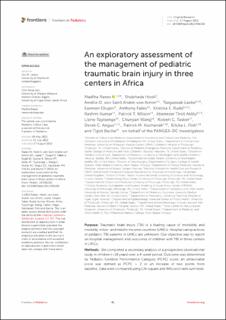| dc.contributor.author | Raees, Madiha | |
| dc.contributor.author | Hooli, Shubhada | |
| dc.contributor.author | von Saint André-von Arnim, Amélie O. | |
| dc.contributor.author | Teklemariam, Tsegazeab Laeke | |
| dc.contributor.author | Otupiri, Easmon | |
| dc.contributor.author | Fabio, Anthony | |
| dc.contributor.author | Rudd, Kristina E. | |
| dc.contributor.author | Kumar, Rashmi | |
| dc.contributor.author | Wilson, Patrick T. | |
| dc.contributor.author | Aklilu, Abenezer Tirsit | |
| dc.contributor.author | Tuyisenge, Lisine | |
| dc.contributor.author | Wang, Chunyan | |
| dc.contributor.author | Tasker, Robert C. | |
| dc.contributor.author | Angus, Derek C. | |
| dc.contributor.author | Kochanek, Patrick M. | |
| dc.contributor.author | Fink, Ericka L. | |
| dc.contributor.author | Bacha, Tigist | |
| dc.date.accessioned | 2022-12-15T14:45:45Z | |
| dc.date.available | 2022-12-15T14:45:45Z | |
| dc.date.created | 2022-11-14T11:06:52Z | |
| dc.date.issued | 2022-08-17 | |
| dc.identifier.issn | 2296-2360 | |
| dc.identifier.uri | https://hdl.handle.net/11250/3038101 | |
| dc.description.abstract | Purpose: Traumatic brain injury (TBI) is a leading cause of morbidity and mortality in low- and middle-income countries (LMICs). Hospital care practices of pediatric TBI patients in LMICs are unknown. Our objective was to report on hospital management and outcomes of children with TBI in three centers in LMICs.
Methods: We completed a secondary analysis of a prospective observational study in children (<18 years) over a 4-week period. Outcome was determined by Pediatric Cerebral Performance Category (PCPC) score; an unfavorable score was defined as PCPC > 2 or an increase of two points from baseline. Data were compared using Chi-square and Wilcoxon rank sum tests.
Results: Fifty-six children presented with TBI (age 0–17 y), most commonly due to falls (43%, n = 24). Emergency department Glasgow Coma Scale scores were ≤ 8 in 21% (n = 12). Head computed tomography was performed in 79% (n = 44) of patients. Forty (71%) children were admitted to the hospital, 25 (63%) of whom were treated for suspected intracranial hypertension. Intracranial pressure monitoring was unavailable. Five (9%, n = 5) children died and 10 (28%, n = 36) inpatient survivors had a newly diagnosed unfavorable outcome on discharge.
Conclusion: Inpatient management and monitoring capability of pediatric TBI patients in 3 LMIC-based tertiary hospitals was varied. Results support the need for prospective studies to inform development of evidence-based TBI management guidelines tailored to the unique needs and resources in LMICs. | en_US |
| dc.language.iso | eng | en_US |
| dc.publisher | Frontiers | en_US |
| dc.rights | Navngivelse 4.0 Internasjonal | * |
| dc.rights.uri | http://creativecommons.org/licenses/by/4.0/deed.no | * |
| dc.title | An exploratory assessment of the management of pediatric traumatic brain injury in three centers in Africa | en_US |
| dc.type | Journal article | en_US |
| dc.type | Peer reviewed | en_US |
| dc.description.version | publishedVersion | en_US |
| dc.rights.holder | Copyright 2022 the authors | en_US |
| dc.source.articlenumber | 936150 | en_US |
| cristin.ispublished | true | |
| cristin.fulltext | original | |
| cristin.qualitycode | 1 | |
| dc.identifier.doi | 10.3389/fped.2022.936150 | |
| dc.identifier.cristin | 2073369 | |
| dc.source.journal | Frontiers in pediatrics | en_US |
| dc.identifier.citation | Frontiers in pediatrics. 2022, 10, 936150. | en_US |
| dc.source.volume | 10 | en_US |

